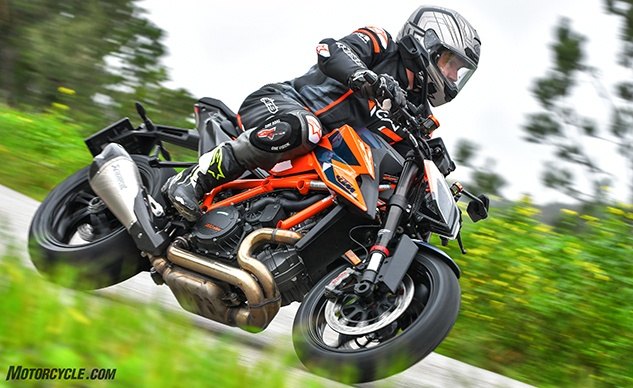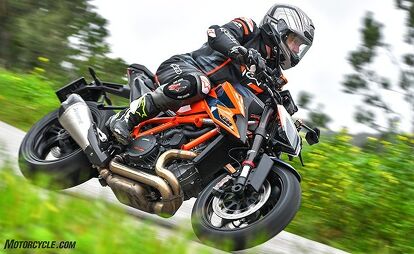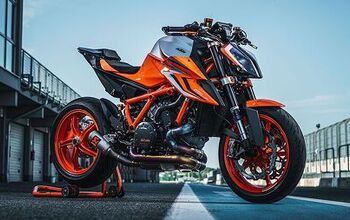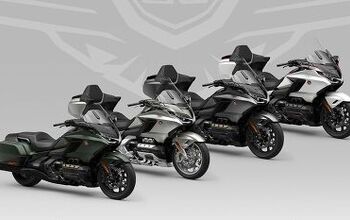2020 KTM 1290 Super Duke R Review - First Ride

Friendlier yet beastlier than ever
The KTM 1290 Super Duke R has always been a sledgehammer of a motorcycle. While the blunt instrument approach to producing power has its fans, there is something to be said about using a little finesse when dishing out a gut punch. With the development of the 2020 model, which KTM has dubbed “The Beast 3.0,” the focus was on refining the techniques the Super Duke R uses as it brutalizes the laws of physics. And I think that it will produce even bigger smiles on the hearty souls who choose this mount to beat their local tarmac into submission.
2020 KTM 1290 Super Duke R
| Engine | 18.5/20 |
| Suspension/Handling | 13.5/15 |
| Transmission/Clutch | 9.0/10 |
| Brakes | 9.0/10 |
| Instruments/Controls | 4.25/5 |
| Ergonomics/Comfort | 8.75/10 |
| Appearance/Quality | 9.0/10 |
| Desirability | 9.5/10 |
| Value | 8.5/10 |
| Overall Score | 90/100 |
2014 KTM Super Duke R Review – First Ride
2017 KTM 1290 Super Duke R First Ride Review
While the KTM 990 Super Duke was introduced in 2005, the 990 Super Duke R didn’t make the scene until 2007. That, however, was only the teaser for the first iteration of The Beast, the 1290 Super Duke R, that has relied on KTM’s 1301 cc LC8 engine since it was first unleashed in 2014 in a form that was impressive enough to win our 2014 Motorcycle of the Year award. In 2017, the most powerful engine offered by KTM underwent some modifications along with a variety of electronic updates for version 2.0.
Get the Flash Player to see this player.
For the third iteration, KTM brought the world moto-press to the famed Portimão Circuit, officially known as Autodromo Internacional de Algarve, for a chance to sample the 2020 KTM 1290 Super Duke R around one of the most technically challenging motorcycle circuits in the world. What better way to see how KTM’s latest refinements have redirected the fury of the Beast for the hands of us mere mortals.
The heart of the beast
The Super Duke R’s engine remains the 1301cc 75° V-Twin LC8 of its predecessor, but that doesn’t mean it hasn’t undergone major changes for 2020. The overriding goal of the update was to massage the power output while reducing weight. With a claimed increase of 3 hp at the crank, the LC8 puts out 180 hp – which should translate to roughly 160 hp at the rear wheel. However, the story here is about the torque. KTM claims a peak torque (again at the crank) of 103 lb-ft at 8,000 rpm. What should really excite riders, though, is the usability of the torque in the bottom end and mid-range. With roughly 74 lb-ft available at just 3,000 rpm, the numbers rise to 4,500 rpm cranking out 89 lb-ft and continues pretty consistently to its peak. With these numbers, twisting the throttle should get your blood pumping!
One of the goals of the 2020 update was to try to lose 5% of the weight of every part that was changed, and in the case of the engine, that means quite a bit of parts. For example, the bracing within the engine was reduced to the minimum. The result is an 800 g (1.76 lb) weight reduction in the cases alone. Other refinements were also made to the oil routing throughout the engine, reducing both frictional losses and weight. A new water pump also helps to shave weight.
To feed the Beast, the new, 2.8 L larger airbox now incorporates ram air. The split between the headlights is now fully functional, letting high-speed air directly into the mesh-covered intake. Additionally, the new air filter location assists in keeping it clean, with bigger bits of crud falling safely to the bottom of the chamber. Top feeder fuel injectors provide better fuel atomization at high rpm. To meet Euro 4 certification and be ready for Euro 5, the exhaust system was updated to include two catalysts. The header pipes are different diameters (54mm front and 60mm rear) to account for the longer length of the rear header and balance exhaust gas flow. Despite the additional weight of the second catalyzer, the stainless steel exhaust system still weighs in 1 kg (2.2 lb.) lighter than before.
Engines aren’t just about making power, though. You have to get it to the ground. The gearbox is built by Pankl Racing Systems and features a shorter, lighter shifting throw. This pays off every time you lift or press your left foot on the shifter. One other cool tidbit is that the shifter itself has an adjustable throw, with longer options available to the rider. Finally, the shift and assist clutch benefits from new clutch plates, featuring rotated pads that offer more complete disengagement which KTM claims has a significant effect at low engine speeds.
Changes to the chassis
The subtext to the Super Duke R’s chassis changes includes a new frame that shaved off 2 kg (4.4 lb.). The big news revolves around how the new frame affects the bike’s handling, which was made sharper for both the street and track. KTM claims three times the torsional stiffness from a new trellis frame that utilizes the LC8 engine as a stressed member. The rake increased from 24.9° to 25.2°, and the trail remains 4.2 in. Additionally, while losing 200 g (7 oz.), the triple clamp received 3mm more offset to deliver more feeling to the rider for precise steering inputs. To assist in directional changes both at the entry and mid-corner, the engine was lifted 38mm in the frame, giving the SDR a higher center-of-gravity.
The single-sided swingarm also went on a diet while gaining 15% more stiffness. In an interesting touch, the swingarm’s brace was moved to the bottom of the unit. Finally, to improve the anti-squat of the rear suspension under acceleration, the swingarm pivot was raised 5mm higher on the engine cases.
With this many changes to the chassis, you won’t be surprised to learn that the WP suspension is all new for 2020. The WP Apex 48 open cartridge fork offers compression, rebound, and preload adjustments with the compression and rebound circuits in separate fork legs.
The WP Apex Monoshock has compression (high and low speed) and rebound adjustments, while a remote knob controls the hydraulic preload. The shock also received a new linkage that allows the shock stroke to go from 54mm to 70mm. This longer stroke gives the shock more movement to absorb bumps because the movement requires more oil to flow through the damping circuits. Additionally, the larger oil volume helps prevent overheating. Even with all that cool stuff, WP managed to remove another 200 g from the SDR.
At the business end of those front and rear suspenders, we can’t forget to mention the wheels, brakes, and tires. The wheels are new, stronger-but-lighter cast aluminum items shod with Bridgestone S22 tires. The rear S22 was designed in a joint effort between KTM and Bridgestone. This special rear has a softer carcass, giving the rubber more mechanical grip through a larger contact patch – further assisting in helping the SDR maintain its line when exiting a corner. To negate the effects of speed acceleration generates, KTM uses a Brembo radial master cylinder feeding the company’s latest, greatest Stylema calipers (saving 90 g compared to M50s) which clamp a pair of 320mm discs.
The subframe was changed to a cast aluminum unit similar to that on the 790 Duke, but in addition to the aluminum portion a carbon composite section allows for 1.5 kg (3.3 lb) weight reduction. Also, every piece of bodywork was made with thinner center sections and thicker edges where they needed strength. The bodywork’s swoopy design isn’t just styling either. It is designed to add downforce to the front wheel from 100mph to the SDR’s top speed.
Finally, one change that I have mixed feelings about is the reshaped tank to better support the rider under braking. However, that noble goal comes at the cost of 0.5 gallons of gas – though, I do suspect the larger airbox also plays a role in the reduction of fuel capacity to 4.2 gal.
Technology
While the rider’s aids may have the same names as on the previous generation SDR and you already know what their general duties are, they have been completely reworked for 2020. I don’t think that I need to explain the differences between Rain, Street, and Sport modes. While only Rain reduces power output, they all – as you move from left to right – offer increasingly more aggressive throttle maps and less intrusive traction control. You may have noticed an absence in the modes, though. No, there is no Track mode on the standard 1290. To get that extremely adjustable mode (think the ability to change traction control on the fly via buttons on the left grip, the ability to turn off wheelie control, and Supermoto ABS), you’ll need the $300 Track Pack. If you want the Quickshifter + clutchless up and down shift function, you’ll need to cough up $360. Personally, I feel these functions – particularly the quickshifter – should be part of the standard feature set. Somehow, it feels disingenuous to market a flagship motorcycle that needs upgrades to provide some expected functions all to keep the MSRP artificially low. The good news is that there is a $750 Tech Pack that includes both the Track Pack and the Quickshifter + in addition to Motor Slip Regulation (MSR) and an adaptive brake light which flashes under deceleration.
Even if you never plan on taking your SDR to the track, you should, at the very least, get the Quickshifter +. The step up in refinement from last year’s model is phenomenal. The upshifts are now virtually seamless, and most surprisingly, downshifts can be smoothly made while heeled over entering a corner at track speeds.
The street
My group was lucky to be assigned a street ride in the morning and track in the afternoon. The conditions for the beginning of the street ride were quite dicey. Fog and occasional light drizzle made visibility poor and traction suspect as we traversed winding unfamiliar roads. Although these riding conditions were less than ideal, they provided a good opportunity for testing the SDR’s power delivery and electronics. With the ride mode set in Road, we gamely charged into the elements.
In conditions where abrupt application of the throttle inputs – both off throttle and on – could result in wheel slip, I was able to seamlessly meter out the exact amount of acceleration I desired. No hiccups or lurches presented themselves. The Brembo brakes delivered excellent feel and stopping power even as I was tiptoeing into some corners. The Bridgestone S22s never complained about traction, despite the wetness.
Eventually, the fog burned off, and the pavement dried, letting us truly sample what the roads in Portugal had to offer us. While the pavement was grippy, it was occasionally bumpy. The suspension felt stiffer overall but still soaked up all but the worst of the undulations. And what of the new chassis’ handling characteristics? The SDR turns in quicker and is especially noticeable in S-turns. Much less effort is required to alter lines mid-corner, and unlike the previous model, which wanted to run wide when trail braking, the 2020 1290 not only held its line, but also responded well to mid-corner braking when a decreasing-radius was encountered. Finally, the anti-squat effect of the updated swingarm pivot made it much easier to keep from running wide when hard on the throttle exiting a corner.
The slightly more aggressive upper body position is still all-day comfortable with only the unmolested wind blast – and the speed with which you propel yourself through it – being the limiting factor as far as touring distance is concerned. KTM got the seat foam equation right, delivering the proper balance of firmness for sportifying and plushness for the daily grind. Likewise, the foot pegs meet all of the requirements of my 32-inch inseam, and people who would prefer that they be a tad higher and rearward are in luck since they offer pivoting adjustment around the top mounting bolt.
Track technicalities
Our afternoon on the race track was action-packed with six 20-minute sessions and a mere 10-minute break between each of them. For those of you who are wondering why Portimão? The short answer is that the technical track would allow us to sample the handling of the chassis, the usability of the Super Duke R’s engine, and equally as important, the effectiveness of the upgraded brakes.
The settings I preferred for the track were: Track Mode with the throttle map set to Street, ABS set to Supermoto, and Wheelie Control on (yes, I suck at wheelies). I suppose the setting that stands out is the Street throttle map. Since most of the riders I talked to went for the Sport mapping, I was a little sheepish about my preference until Chris Filmore told me that it was his preferred setting, too. The choice was made solely on my preference to how the engine responded to throttle inputs mid-corner. Although Sport wasn’t abrupt, I’m a rider who values smoothness, and Street gave me just that little extra finesse.
Portimão has a great mixture of tight hairpins mixed with high-speed sweepers all thrown down on an undulating topography offering the chance to accelerate and brake both uphill and down. And then there are the blind corner approaches. Too much fun.
But we’re talking about the power delivery. Although I’d have liked a slightly larger range of neutral throttle, the EFI metered out the power exactly as I asked it to. With the torque curve as broad as the SDR’s, I often had a choice of two gears for many of the corners. Similarly, short shifting as I entered a left hand corner that wouldn’t allow me to get my foot under the shifter if I waited any longer didn’t seem to faze the LC8 at all.
Accelerating out of corners with the TC tickling, where the old SDR would require some additional input to keep it from running wide, the improved anti-squat of the swingarm and the bespoke Bridgestone S22 rear tire kept me on my intended line except on the exit of turn four where the negative camber had me drifting all the way to the curbing more often than not. Let me take a moment to note how well the S22s, a street compound, handled the full day of brutalization that the Super Duke R dished out on the track. Even at the end of the day, when they were quite shagged, they continued to be game at anything I asked them to do.
KTM’s focus on the chassis pays off on the track. Whereas, with the previous generation SDR, the bike would try to stand up when trail braking, 3.0 has no such tendency. Instead, I could carry the brakes all the way to the apex if I wanted. One particular corner highlights how much feel the Brembos offered. The approach is downhill before the left turn takes you across the hill, resulting in negative camber. To complicate things the exit of the corner decreases its radius slightly. With this Brembo system, I was able to comfortably carry my brakes most of the way through the corner until I was lined up for the exit.
The 1290 Super Duke R’s acceleration needs to be experienced on the track for full appreciation of what it can do. The long right-hander onto the front straight starts off downhill before climbing back up. As the hill flattens out for the bulk of the straight, the SDR will loft its front wheel in 5th gear! And then the wind blast gets really interesting – particularly for those of us who aren’t as aerodynamic as we used to be and find it difficult to crawl under the tank’s paint. Any time the bike got over 100 mph, the wind blast was impressive, but as the speed approached 150 mph, the force was enough to press my helmet against my face hard enough to blur my vision. Also, I’d be remiss if I didn’t point out that there were other riders on the track – with names like Chris Filmore and Jeremy McWilliams – who were traveling significantly faster than me.
Back in the pit box
Each 10 minute break between track sessions was barely enough for me to come down after my previous one, but every time the track went hot again, I was throwing my leg over the bike to go out for another 20-minute fix. What is so nice about this KTM is its track prowess doesn’t make it any less of an enjoyable street bike. The suspension is decidedly firmer but not uncomfortably so in the real world. The refined power delivery works as well in the closed course environment as it does on mountain roads. My only real complaint I have about the 2020 KTM 1290 Super Duke R is that the $18,699 base model lacks a lot of the technology that makes the SDR the great bike that it is. Not including the quickshifter on this bike standard is a crime. So, go in with your eyes open and expect to pay the $750 for the Tech Pack to get most of the options that a performance street rider will likely want. After that, the only thing left to decide is will it be orange or black?
2020 KTM 1290 Super Duke R
+ Highs
- Brutally sexy torque curve
- Quicker steering
- Lighter weight
– Sighs
- Base package leaves a lot of built-in technology on the table
- Slightly smaller fuel capacity
- A threat to society (or is that a High?)
In Gear

Helmet: 6D ATS-1R $745
- Leathers: Alpinestars GP Pro V2 $1,300
- Air Bag System: Alpinestars Tech Air Race Vest $1,150
- Gloves: Alpinestars Supertech Gloves $400
Boots: Alpinestars Supertech-R Boots $500
2020 KTM 1290 Super Duke R | |
|---|---|
| MSRP | $18,699 |
| Engine Type | 1301 cc, 75° V-Twin, liquid-cooled |
| Bore and Stroke | 108mm x 71 mm |
| Fuel System | Keihin EFI (throttle body 56 mm) |
| Compression Ratio | 13.5:1 |
| Valve Train | 4 valves per cylinder, DOHC |
| Transmission | 6-speed, PASC slipper clutch, hydraulically operated |
| Final Drive | Chain |
| Front Suspension | WP APEX 48, preload, compression, rebound adjustable |
| Rear Suspension | WP APEX Monoshock, compression (high and low speed), rebound, hydraulic preload |
| Front Brake | 2 x Brembo Stylema Monobloc four piston, radially mounted caliper, 320 mm discs |
| Rear Brake | Brembo two piston, fixed caliper, 240 mm disc |
| Front Tire | 120/70 ZR 17, Bridgestone S22 |
| Rear Tire | 200/55 ZR 17, Bridgestone S22 (special construction) |
| Rake/Trail | 25.2°/4.2 inches |
| Wheelbase | 58.9 inches |
| Seat Height | 32.9 inches |
| Curb Weight | 461.7 pounds (wet, claimed) |
| Fuel Capacity | 4.2 gallons |
| Available Colors | Orange, Black |

Like most of the best happenings in his life, Evans stumbled into his motojournalism career. While on his way to a planned life in academia, he applied for a job at a motorcycle magazine, thinking he’d get the opportunity to write some freelance articles. Instead, he was offered a full-time job in which he discovered he could actually get paid to ride other people’s motorcycles – and he’s never looked back. Over the 25 years he’s been in the motorcycle industry, Evans has written two books, 101 Sportbike Performance Projects and How to Modify Your Metric Cruiser, and has ridden just about every production motorcycle manufactured. Evans has a deep love of motorcycles and believes they are a force for good in the world.
More by Evans Brasfield





































































Comments
Join the conversation
Great looking bike except for those hideous, bug eye headlights. Time to move on from those, KTM!
Guys, which tyres will be good for Honda Shadow Phantom and wet autums road?
Is anybody used Dunlops tires (found these article with Dunlops tires https://www.bestadvisers.co...
Thanks